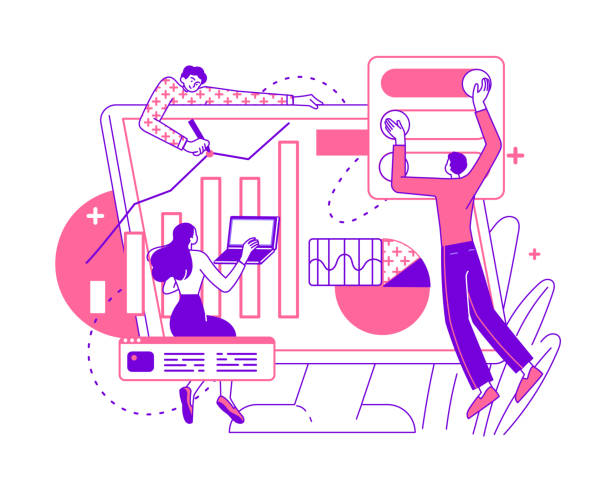The Importance of Speed in Today’s Digital World

In the current era where speed is paramount, web design is not limited to aesthetic appeal, but its #speed and #efficiency are equally vital.
Today’s users are more impatient than ever and expect web pages to load in a fraction of a second.
A website that loads slowly not only loses its visitors but also negatively impacts its credibility and ranking in search engines.
A fast website design significantly improves user experience (UX), reduces Bounce Rate, and greatly helps increase Conversion Rate.
This is crucial not only for online businesses but also for any website looking to attract and retain an audience.
Understanding the importance of speed is the first step towards achieving a successful website.
It is an undeniable fact that slow websites are doomed to fail in today’s competitive market.
Does your current corporate website present a worthy image of your brand and attract new customers?
If not, turn this challenge into an opportunity with RasaWeb’s professional corporate website design services.
✅ Dramatically improves your brand’s credibility and image.
✅ Paves the way for attracting leads and new customers for you.
⚡ Contact RasaWeb now for a free and specialized consultation!
Key Factors Affecting Website Speed

To achieve an #optimized and fast #website, one must first become familiar with the #factors_affecting speed.
These factors include technical infrastructure, coding, and site content.
One of the most important factors is the quality of hosting.
Inexpensive shared hosting might save costs but often leads to slow website loading.
Using optimized and powerful servers or even a CDN (Content Delivery Network) is essential to reduce response time.
The next factor is website code optimization.
Messy code, excessive JavaScript and CSS, and heavy fonts can all decrease loading speed.
Additionally, unoptimized images and videos consume a large amount of bandwidth and significantly increase loading time.
Optimizing image sizes and using appropriate formats is a crucial step in fast website design.
Speed Optimization Techniques and Tools

Achieving #high_speed on a website requires utilizing #modern_techniques and specialized tools.
The first step is file compression with Gzip, which significantly reduces the size of HTML, CSS, and JavaScript codes.
Using the Minification technique to remove extra characters, spaces, and comments from codes improves loading speed.
Caching is also a vital strategy; by storing copies of pages and resources in users’ browsers, the need to reload information from the server on subsequent visits is reduced.
Furthermore, using Lazy Loading for images and videos, meaning this content only loads when the user needs it, significantly impacts the initial site speed improvement.
Below, you can see a table of some of the most popular speed optimization tools:
| Tool Name | Main Use | Key Feature |
|---|---|---|
| Google PageSpeed Insights | Website performance analysis (mobile and desktop) | Provides speed scores and improvement suggestions |
| GTmetrix | Comprehensive speed and performance analysis | Waterfall reports and in-depth analysis |
| WebPageTest | Speed testing from different locations | Ability to simulate various internet connections |
| Smush (WordPress Plugin) | Image optimization and compression | Lossless compression |
Using these tools helps you identify your website’s weaknesses and make precise plans for fast website design.
The Role of Responsive Design and Mobile Optimization in Speed

In today’s world, a significant portion of web traffic comes from mobile devices.
Therefore, #Responsive_Design and #mobile_optimization are not just an option, but a necessity for #modern_websites.
A website that is not properly optimized for mobile not only provides a poor user experience but also has its loading speed severely reduced on mobile devices.
Responsive design means that your website automatically adjusts its size and layout to fit the screen size of the user’s device.
This prevents the loading of additional or heavy content for mobile devices.
In addition to responsive design, special attention should be paid to optimizing images for mobile, using low-volume web fonts, and avoiding heavy and unnecessary scripts for mobile.
Google has also explicitly stated that mobile speed and user experience are important ranking factors in SEO.
Therefore, a fast and responsive website design is crucial for success in mobile searches.
This section of the Core Web Vitals discussions is also strongly emphasized by Google.
Do you dream of a thriving online store but don’t know where to start?
RasaWeb is your comprehensive e-commerce website design solution.
✅ Attractive and user-friendly design
✅ Increased sales and revenue⚡ Get a free consultation
The Impact of Loading Speed on SEO and User Experience

The relationship between #website_speed, #SEO, and #user_experience is a direct and highly critical cycle.
Search engines like Google prioritize websites that load quickly and offer a good user experience.
#Slow_websites face a reduced crawl rate by search engine bots, which can lead to fewer pages being indexed and, ultimately, a drop in search results ranking.
From a user’s perspective, a slow website can be very frustrating.
Studies have shown that even a one-second delay in page loading can decrease the conversion rate by up to 7% and significantly increase the bounce rate.
#Engaging_content is valuable only if the user can access it quickly.
Therefore, any investment in speed optimization is, in fact, an investment in SEO and user experience improvement.
A fast website design means better SEO and more satisfied users.
Common Mistakes That Slow Down Website Speed

Have you ever wondered why your website is slow, even though you’ve put all your effort into optimizing it? Often, #common_mistakes and seemingly small ones can have a big impact on #site_loading_speed.
One of the biggest mistakes is using high-volume and unoptimized images.
A 5MB image alone can cause severe website slowdown.
Another is the lack of caching or incorrect settings, which causes the user to load all site resources from scratch every time.
#Excessive_JavaScript and #CSS_scripts without compression can also significantly increase loading time.
Sometimes, using too many or poor-quality plugins in content management systems like WordPress is the main cause of slowness.
Choosing unsuitable hosting and not using a CDN are also common mistakes.
To achieve a fast website design, one must be aware of these mistakes and rectify them through regular website performance checks.
Which of these problems is your website suffering from?
Choosing the Right Hosting and CDN for Speed

One of the most important decisions in the path to #website_speed_improvement is choosing the right #hosting and #CDN (Content Delivery Network).
Poor hosting, even with the best coding and optimizations, can slow down your website.
Optimized hosting like VPS, Dedicated Server, or Cloud Hosting offers better responsiveness.
Features like SSD storage, new PHP versions, and Nginx instead of Apache can significantly impact speed.
CDN is also a powerful complement to hosting.
By storing copies of your website’s static content (such as images, CSS, and JavaScript) on various servers worldwide, CDN delivers content from the closest point to the user, minimizing latency.
This is especially vital for websites with visitors from different geographical locations.
Choosing these two optimized infrastructure elements is a big step towards fast website design.
The table below provides a comparison between different types of hosting and CDN:
| Service Type | Key Features | Suitable For | Impact on Speed |
|---|---|---|---|
| Shared Hosting | Sharing resources with multiple users, lowest price | Small and nascent websites | Low, prone to slowness |
| VPS Hosting | Virtual dedicated resources, high flexibility | Medium websites with growing traffic | Medium to good |
| Dedicated Server | Full dedicated server, highest control and power | Large and high-traffic websites | High, optimal performance |
| Cloud Hosting | High scalability, pay-as-you-go | Websites with variable traffic and need for flexibility | High, stability and high speed |
| CDN (Content Delivery Network) | Delivering content from the nearest server to the user | All websites, especially those with global audiences | Significant increase in loading speed |
These choices form the foundation of your fast website design.
Future Trends in Web Performance Optimization

The #web world is constantly changing and evolving, and #web_performance_optimization is no exception.
#New_trends and emerging technologies are shaping the future of fast websites.
One of the most important is the emergence of WebAssembly, which enables high-performance code execution in the browser.
Another is the wider adoption of Progressive Web Apps (PWAs), which offer a user experience close to native applications with web speed and accessibility.
Also, the focus on Google’s Core Web Vitals indicates that the importance of speed and interactivity metrics in search engine rankings will increase further.
HTTP/3 and newer communication protocols also help improve the speed of communication between the browser and the server.
These trends show that fast website design is not just a competitive advantage but will become an essential standard in the future, and developers must align themselves with these changes.
Did you know that customers’ first impression of your company is your website? Multiply your business’s credibility with a powerful corporate website from RasaWeb!
✅ Custom and eye-catching design tailored to your brand
✅ Improved user experience and increased customer acquisition⚡ Get a free consultation!
Measuring and Monitoring Website Speed

To ensure that your efforts to optimize speed have been successful, #continuous_measurement and #monitoring of #website_performance is essential.
Tools like Google PageSpeed Insights, GTmetrix, and WebPageTest help you check loading speed, Time to First Byte (TTFB), and other key metrics.
These tools not only provide performance scores but also offer suggestions for improvement.
In addition to manual tests, using Application Performance Monitoring (APM) tools that continuously monitor website speed and stability can be very beneficial.
These tools send necessary alerts if problems occur, allowing you to resolve them before users notice.
Regular monitoring helps you ensure that your fast website design is maintained over time and that new changes or increased traffic do not lead to performance degradation.
Ultimate Guide to Achieving High-Speed Websites

In summary, achieving a #high-speed_website is the result of a combination of #technical_knowledge, #continuous_optimization, and a #commitment to providing the best user experience.
This is an ongoing journey, not a final destination.
From the outset, during the #site_design_phases, think about speed.
Use quality hosting and a reliable CDN.
Optimize site coding, use Minification and Gzip, and load JavaScript and CSS asynchronously.
Compress images and utilize Lazy Loading.
Implement caching correctly.
Design your website responsively and optimize it for mobile.
Regularly use speed analysis tools and review reports to identify and address weaknesses.
By adhering to these principles, you can have a website that is not only fast but also enjoyable for its users and likable for search engines.
Investing in fast website design is an investment in the long-term success of your online business and differentiates you from competitors.
Frequently Asked Questions
| Question | Answer |
|---|---|
| What is fast website design? | The process of building a website that loads quickly and provides a smooth user experience. |
| Why is website speed important? | Improved user experience, reduced bounce rate, increased conversion rate, and better search engine ranking (SEO). |
| What factors affect website speed? | Image size, number of HTTP requests, code optimization (HTML, CSS, JS), hosting speed, and browser cache. |
| How can website speed be improved? | Image optimization, file compression, caching, choosing appropriate hosting, and reducing unnecessary plugins. |
| How do images affect website speed? | High-volume or improperly formatted images can significantly increase page loading time. |
| What is the role of JavaScript and CSS in website speed? | Unoptimized, high-volume, or render-blocking codes can reduce page rendering speed. |
| How much does hosting affect website speed? | The speed and quality of the hosting server directly impact website response time and initial loading speed. |
| What tools are available for checking website speed? | Google PageSpeed Insights, GTmetrix, Pingdom Tools are common tools. |
| What are the advantages of a fast website? | Greater user satisfaction, reduced bounce rate, increased time on site, and improved ranking in Google results (SEO). |
| What are common mistakes that slow down website speed? | Using unoptimized images, bulky and messy coding, excessive use of plugins, and not using caching. |
And other services of RasaWeb Advertising Agency in the field of advertising
Smart Customer Journey Map: An effective tool to improve SEO ranking with the help of SEO-driven content strategy.
Smart Data Analysis: Revolutionize online growth with smart data analysis.
Smart Conversion Rate Optimization: Professional optimization for online growth using smart data analysis.
Smart Custom Software: Designed for businesses looking to manage campaigns through smart data analysis.
Smart Advertorial: A creative platform to improve customer behavior analysis with precise audience targeting.
And over a hundred other services in the field of internet advertising, advertising consultation, and organizational solutions
Internet Advertising | Advertising Strategy | Advertorial
Resources
- Digikala Mag Website Design Articles
- Zoomit: Web Design
- Iran Developers: Web Design Tips
- Namatek: Website Speed Improvement
? For your business to thrive in the digital world, RasaWeb Afarin Digital Marketing Agency is your smart companion. With us, you will have a complete experience of professional services, from website design with a modern user interface to comprehensive SEO and content marketing strategies.
📍 Tehran, Mirdamad Street, next to Central Bank, Southern Kazerun Alley, Ramin Alley, No. 6



